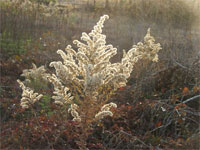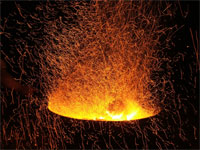Native Son – December, 2008
Bois d’Arc Magic

A wetlands sanctuary, as nature reveals it at the Heard Wildlife Sanctuary in McKinney. All photos by Steven Chamblee.

Goldenrod inflorescences.
I’m one of those people who get the blues during the holiday season, which I have learned, isn’t all bad. Instead of heading to the malls and big box stores, I seek comfort in nature and earthy things. And so it was after a mellow Father Christmas photo session, when I hung up the red robe and headed out across the magnificent prairie remnants of the Heard Sanctuary. Instantly, I am standing amidst billows of spent goldenrod inflorescences that float above the grasses and, backlit by the sun, look like little pieces of heaven that have fallen to the earth. The birds are singing, the air curls around me, and once again, I succumb to the true gifts of nature.

Bois d’arc (Maclura pomifera) fruit.
I quickly encounter a “herd” of bois d’arc (Maclura pomifera) fruits on the ground. Often called horseapples, these heavy, grapefruit-sized wonders have always made me feel good simply for their intrinsic value. I have heard tell of many people-uses for them, from mosquito repellent to cockroach killers, though I think it would be easier just to step on the cockroach. The puckery surface of the fruits is technically called “tuberculated,” which always makes me think of giraffes (”reticulated”). Horseapples smell interesting inside — not particularly nice or unpleasant or reminiscent of anything else, so it’s hard to describe. (I can just hear my buddy Mark….”If you can’t describe it, why did you bring it up?” Come to think of it, Mark’s kind of difficult to describe as well … hmmm … oh, I see his point.) Folks up north call these trees/fruits “Osage orange,” and say they smell like oranges, but, personally, I don’t get any citrus scent out of them.
But my favorite thing about these horseapples is that no one really knows what purpose they serve. This is interesting, since we humans have finally figured out that everything in this world has a purpose, whether that purpose serves us or not. Nothing really eats these horseapples — not horses, cattle, or even the squirrels and opossums that occasionally tear into them out of curiosity. Personally, I like the modern thought that some of the large mammals that went extinct at the end of the Ice Age ate them. And why wouldn’t a giant ground sloth or wooly mammoth find them tasty? Probably good fiber anyway, and I can think of no better purpose for a plant than keeping a giant sloth regular.
In contrast, the tree itself has served mankind well in many ways, including superior wood for Native American and some modern wooden bows (bois d’arc is French for “arc of the bow”). The wood is hard and very decay-resistant, making it useful for outdoor building materials. (The Heard Museum has some bois d’arc fence posts that are over 100 years old, and Weston Gardens in Fort Worth still has some of the bois d’arc bricks that were originally used to pave Camp Bowie Boulevard. That’s right … wooden bricks!)

A bois d’arc fire.
I remember well walking the trails at the Fort Worth Botanic Garden with forester (and then TCJC instructor) Larry Schaapveld, who concurred with my father’s observation that the orange-colored wood creates the most exciting fire ever. When burned, bois d’arc wood pops and snaps and spews colorful gasses, making great entertainment for folks who enjoy the simple pleasure of a lovely hearth fire. Years later, my son and I joined Larry for a spectacular pit fire at his home — one of my favorite family memories. (A word of caution: Never burn this wood inside if you do not have a glass fireplace enclosure. The sparks will go through even a fine screen.)
I look up to find myself lost in wonder and memory … 30 feet down the mile-long Bluestem Trail, and I’m the only soul in sight. Wow. Up ahead lies the Bullfrog Pond, the old Aquatic Lab building, and 100-plus acres of wetlands bristling with ducks, cormorants, and who knows what else. This could take hours … days. Looks like all those holiday crowds and crazy traffic and expensive shopping will have to wait. Yeah … I’m good with that.
About the author: Steven Chamblee is the chief horticulturist for Chandor Gardens in Weatherford and a regular contributor to Neil Sperry’s GARDENS magazine and e-gardens newsletter.

